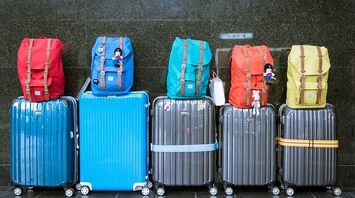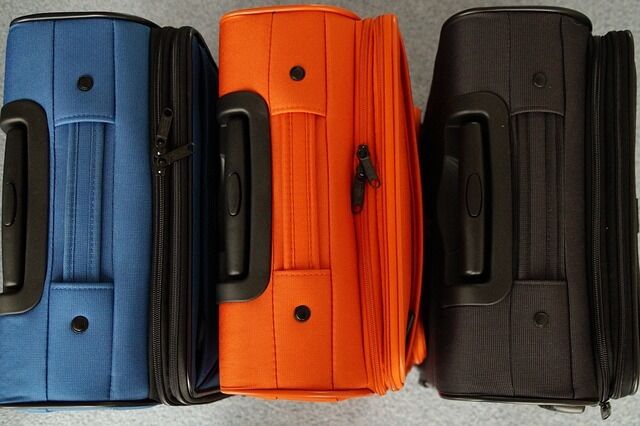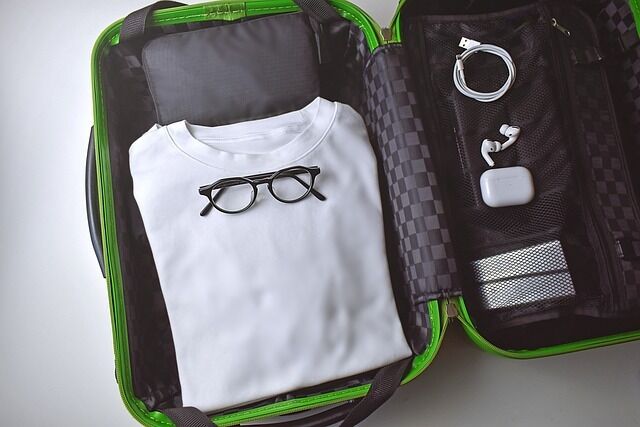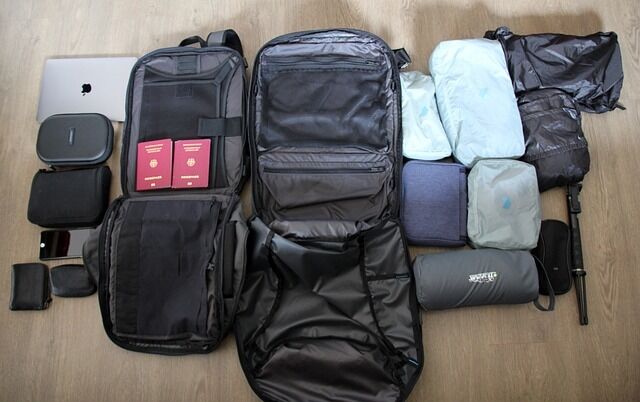Packing a suitcase? A list of things you can't take on an airplane

Traveling by plane is always an exciting adventure, but it requires some preparation, especially when it comes to packing. Hand luggage and baggage rules at airports are quite strict, and it is important to know what you can and cannot take on board. Following these rules will not only help you avoid unpleasant situations at security checks, but will also make your trip more comfortable and relaxing. In this article we will tell you what items you should leave at home or put in your checked luggage to make your trip smooth and hassle-free.
Restrictions on liquids
When it comes to carry-on luggage, one of the most important rules concerns the transportation of liquids. Airports have a strict restriction: all liquids you take on board must be packed in containers of no more than 100 ml. This rule applies to all types of liquids, including water, juices, cosmetics, lotions and even gels.
How to pack liquids correctly
To comply with the rules, all your bottles and vials should be placed in one clear plastic bag with a maximum volume of one liter. The bag should be easy to close and airtight. You will need to take this bag out of your hand luggage and place it separately on the tape when going through security. This way, security will be able to check its contents quickly and efficiently.
Exceptions to the rules
There are a few exceptions that make your travel a little easier.
- Medications. If you need to take more than 100 ml of liquid medications in your first aid kit, be sure to bring a prescription or medical certificate confirming the need for these medications.
- Baby food. For passengers with small children, it is allowed to take the necessary amount of baby food and milk. They are also subject to inspection, but are not limited by the 100 ml rule.
By following these simple rules, you will avoid delays and hassles when going through security control at the airport.

Prohibited items
Passenger safety is a top priority at any airport, which is why there are strict rules regarding items that cannot be taken on board an airplane in carry-on luggage. Violating these rules can lead to delays, fines or even serious consequences. Below is a table with the main categories of prohibited items and examples.
|
Category |
Prohibited items |
Notes |
|
Weapons and sharp objects |
Knives, scissors, razors, screwdrivers, pliers. |
Exception: safety razors (disposable) |
|
Explosive and flammable substances |
Pyrotechnics, fireworks, flammable liquids and gases |
Includes gas cans and lighters |
|
Sports equipment |
Baseball bats, golf clubs, ski poles |
Any equipment that can be used as a weapon |
|
Tools |
Hammers, saws, drills |
All types of tools must be in checked luggage |
|
Toys and replica guns |
Toy guns, replica guns |
Even non-working replicas are prohibited |
Prohibited items can include many different objects, and it is important to read the rules carefully before traveling. Some items that may seem harmless also fall under the ban if they can be used as weapons or pose a flight hazard.
Electronic devices and batteries
Electronic gadgets are an integral part of our daily lives, and many of us take them with us even when traveling. However, when flying, there are certain rules and restrictions regarding the transportation of electronic devices and batteries in hand luggage.
Restrictions on lithium-ion batteries
The lithium-ion batteries used in most modern electronic devices can be dangerous if not transported properly. Here are the basic rules when flying.
- Spare batteries. Lithium-ion batteries (such as those for cameras, laptops or external batteries) should be packed in your carry-on baggage. These batteries are not allowed in checked baggage.
- Battery capacity. Batteries with a capacity of up to 100 W⋅h can be carried without restrictions. Batteries with a capacity of 100 to 160 W⋅h may be carried only with the airline's authorization (usually no more than two per passenger).
- Contact Protection. All spare batteries must be protected against short circuits by using individual packages or insulating materials.
Ensure that all batteries comply with transportation regulations and do not pose a hazard.
Prohibited devices
Some electronic devices may not be allowed in carry-on luggage:
- Drones with lithium-ion batteries may be prohibited for carriage or require special authorization.
- Electronic cigarettes. Allowed in carry-on baggage but prohibited for use on board. Carriage in checked baggage is prohibited.
- Self-balancing devices. Gyroscooters and other self-balancing devices are generally prohibited for transportation due to large batteries.
Follow these rules to save time for check-in.
Specific requirements
Some devices require special handling during transportation.
- Laptops and tablets. These devices must be easily accessible, as they are often asked to be taken out of your carry-on baggage when going through security. All laptops and tablets should be charged so they can be turned on for screening.
- Chargers and adapters. Usually allowed in transit, but must be packed carefully so as not to damage other items in your carry-on luggage.
Make sure all your electronic devices meet airline and airport requirements, and enjoy a hassle-free flight.

Food items
Carrying food items in your hand luggage can be a challenge, especially given the strict security regulations at airports. It's important to know which foods are allowed and which are better left at home or packed in checked luggage.
Allowed foods
Many types of food can be brought on board as long as they comply with general transportation rules.
- Packaged snacks. Chips, nuts, chocolate bars, and other sealed snacks can be carried without restriction.
- Fruits and vegetables. Fresh fruits and vegetables are allowed, but they must be packaged in clear bags for easy inspection.
- Sandwiches and baked goods. These foods are also allowed, but it is important to keep in mind possible restrictions on liquid fillings (e.g., sauces).
Familiarize yourself with the list so you know for sure what you can bring on board.
Restricted and prohibited products
Some products may not be allowed in your hand luggage or may require special packaging.
- Liquid and semi-liquid products. Soups, yogurts, sauces and any foods with a high liquid content are subject to the 100 ml rule and must be packaged in appropriate containers.
- Animal products. The importation of fresh meat, fish, dairy products and eggs may be restricted or prohibited, especially on international flights. These products are best carried in checked baggage or refused.
- Home-made jams and preserves. Homemade jams, pickles and preserves also fall under the 100ml rule if they contain a significant amount of liquid.
These products should definitely not be taken with you on a flight to avoid delays at security checks.
Conditions for bringing food to other countries
When traveling on international flights, it is important to take into account the rules of importing products into the country of destination.
- Agricultural products. Many countries, including the UK, prohibit the importation of agricultural products to prevent the spread of pests and diseases. Check the specific country's rules before you fly.
- Product declaration. If you are carrying products that may be subject to inspection, make sure they are declared on the customs declaration form. Failure to declare can lead to fines and confiscation.
Knowing the rules of food transportation will help you avoid unpleasant surprises at security checks and customs. Make sure your food is packed properly and compliant.
Additional restrictions for international flights
Traveling abroad requires special attention to the rules for transporting various items, as regulations can vary greatly depending on the destination country. Following international rules not only makes it easier to pass control, but also helps to avoid fines and confiscation of property.
Peculiarities of importing goods to different countries
Each country has its own requirements and restrictions on the importation of various goods:
- Alcohol and tobacco products. Many countries limit the amount of alcohol and tobacco products that can be imported without paying duties. Check the limits for your destination country before traveling.
- Medications. Some medications may be prohibited or require special authorization. Bring a prescription or medical certificate to confirm the need for the medication.
- Cultural and historical items. Items of cultural value may be subject to strict export and import restrictions. Make sure you have the necessary documents and authorizations.
Before flying, be sure to check the restriction of goods to be imported into the country you are flying to.
Preparation tips
To avoid unpleasant situations when going through airport security checks, follow these recommendations:
- Research the rules ahead of time. Make sure you know all the destination country and UK requirements for importing and exporting goods.
- Fill out declarations correctly. Be honest and accurate when completing customs declarations, listing all items to be declared.
- Documents and permits. Bring all necessary documents to prove the legality of importing or exporting goods, including prescriptions for medicines and permits for cultural property.
International travel requires special preparation and attention to import and export regulations. By following these guidelines, you can avoid trouble at customs.

Tips and advice
When going on a trip, it is important to take into account many nuances. Here are some useful tips and recommendations to help you prepare your hand baggage and luggage properly.
How to pack your hand luggage correctly
These tips will help you get through security quickly and without obstacles.
- Use transparent bags. Liquids, gels and aerosols up to 100 ml should be packed in a clear plastic bag with a maximum volume of one liter.
- Organize your belongings. Categorize items and use organizers or small bags.
- Don't overload your bag. Make sure your carry-on baggage meets the allowable size and weight limits set by the airline.
This will make it easier and faster to get through security.
Useful tips for getting through security quickly
Here are some tips to speed up the process
- Have your documents ready in advance. Keep your passport, boarding pass and other important documents in an easily accessible pocket or bag.
- Avoid metal objects. Remove all metal objects, including keys, coins and cell phones, from your pockets before going through the metal detector.
- Remove outerwear and accessories. Jackets, coats, belts and large pieces of jewelry should be removed and placed on the scanning tape.
- Take out electronic devices. Laptops, tablets and other large electronic devices should be taken out of your bag and placed separately for inspection.
By following these simple tips and guidelines, you can avoid many common mistakes and problems.
Useful links and resources
Before traveling, visit the website of the airport from which you are departing to learn about current security and customs restrictions. Familiarize yourself with baggage and carry-on rules to avoid surprises at check-in and boarding.
Being well prepared for your trip is essential for your comfort and peace of mind. Make sure your hand luggage and baggage are properly packed, your documents are prepared in advance, and you are familiar with the current rules and requirements.
Compliance with airport carry-on baggage regulations is an important step towards ensuring the safety and comfort of all passengers. Knowing what you can and cannot take on board an airplane will help you avoid trouble at security checks and make your trip more enjoyable.
By following these guidelines and planning your trip carefully, you will make it as safe as possible. May your flight be pleasant and leave only positive impressions!



















